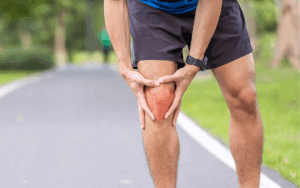
From Marathon Runner to Chronic Knee Pain
This is Tony’s story. He came to us with ongoing knee pain that worsened at work.
Conditions > Joint Pain
Joint pain, also known as arthralgia, is a common issue affecting individuals of all ages.
It can stem from various causes, including injuries, arthritis, or other underlying conditions.
The pain can range from mild discomfort to debilitating agony, impacting your quality of life and daily activities.




Joint pain often results from trauma or injury to the surrounding structures, such as ligaments, bursae, tendons, and muscles. Pain may be localised to a single joint, like the knee or elbow, or affect multiple joints, either on one side of the body or bilaterally, such as in both ankles or wrists.
While the knees are frequently the source of joint pain, discomfort in this area is not always due to a joint issue; it can also arise from damage to the knee cartilage or kneecap. If joint pain affects several joints or occurs on both sides of the body, it could indicate a systemic condition, such as rheumatoid arthritis or psoriatic arthritis.
To diagnose the cause, a thorough examination and imaging may be necessary. Depending on the findings, next steps could include a referral to a specialist, physiotherapy, or guidance on managing pain effectively.
General joint pain can be caused by a variety of conditions, and its signs often overlap with those of arthritis.


Arthritis is a broad term for a range of inflammatory joint diseases. Common signs of arthritis include:
Joint pain can affect many people, but certain groups are more commonly impacted. Older adults are at higher risk due to natural joint wear and tear, often leading to conditions like osteoarthritis. Those with various forms of arthritis, such as rheumatoid or psoriatic arthritis, frequently experience joint pain.
Athletes and individuals involved in high-impact sports or repetitive activities are also more prone to joint injuries. People with a history of joint trauma or obesity, which adds stress to joints, are similarly affected.
Additionally, a genetic predisposition to joint disorders can increase susceptibility. While these groups are more at risk, joint pain can impact anyone, regardless of age or lifestyle.


To help protect your joints, stay active by engaging in regular, low-impact exercises such as swimming or cycling. These activities can strengthen the muscles around your joints and improve flexibility.
Maintaining a healthy weight is also crucial, as excess weight places additional stress on your joints, particularly those in the lower body. A balanced diet combined with regular exercise can assist you in achieving and maintaining a healthy weight.
Additionally, using proper technique during physical activities or when lifting objects can help prevent joint strain or injury. Lastly, staying hydrated is important, as drinking plenty of water helps keep the cartilage in your joints hydrated and functioning properly.
If the pain is affecting just one joint and is not due to injury (the knees are the most common joints to suffer injury), it could be caused by a number of conditions, including:


Pain occurring in many joints around the body is most commonly due to:
Getting to the bottom of the cause of your pain in the joint is the first step towards finding the right treatment and relief. Make an appointment to see one of our doctors, who can help you decide on the best course of action.
We work with experienced consultants & healthcare professionals who have received positive feedback from our patients, and with whom we have established long-term relationships.
Use our online booking engine or book your test by giving us a call.
On the online booking engine select the “appointment type” you need.
You will be seen by one of our friendly doctors or trained clinicians.
Latest Episode
Tune in to our podcast to explore the world of healthcare and learn from distinguished special guests. We cover everything from preventative measures to cutting-edge treatments so that you can stay informed and up-to-date on health-related things.

This is Tony’s story. He came to us with ongoing knee pain that worsened at work.

A lot is said about medical weight loss but we are here to debunk the myths for you.

This is Kate’s story. She visited us last year and saw great improvements in her health and quality of life.
Subscribe for latest updates & news


From same-day private GP and blood test appointments to visa medicals, a sexual and reproductive health clinic, and preventative health screenings, we are here to help.
Contact Us
Accepted Insurance Companies






Please note that Walk-in Clinic is a private medical centre & not an NHS service. Harley Walk-in Clinic Ltd company registration no. 07472804